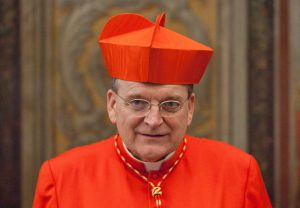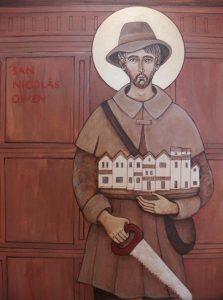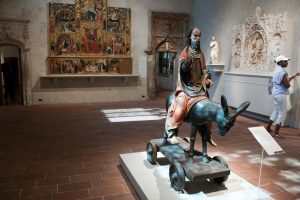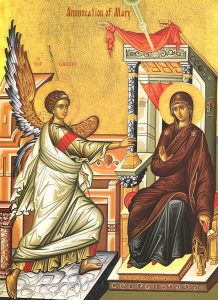“Let us confidently acknowledge and openly proclaim that Christ was crucified for our sake, declaring it with joy and pride, not with fear and shame. In this, the apostle Paul saw reason for boasting. He could have told us many great and holy things about Christ: how as God he shared with his Father the work of creation, and how as man like us he was Lord of the world. But he would not glory in any one of these marvelous things: ‘God forbid that I should boast of anything’, he said, ‘except the cross of our Lord Jesus Christ.’” (St Augustine)
Enmity with God poisons
Enmity with God is the source of all that poisons man; overcoming this enmity is the basic condition for peace in the world. Only the man who is reconciled with God can also be reconciled and in harmony with himself, and only the man who is reconciled with God himself can establish peace around him and throughout the world.
But the political context that emerges from Luke’s infancy narrative as well as in Matthew’s Beatitudes indicates the full scope of these words. That there be peace on earth (cf Lk. 2:14) is the will of God and, for that reason, it is a task given to man as well.
The Christian knows that lasting peace is connected with men abiding in God’s eudokia, his “good pleasure.” The struggle to abide in peace with God is an indispensable part of the struggle for “peace on earth”; the former is the source of the criteria and the energy for the latter.
When men lose sight of God, peace disintegrates and violence proliferates to a formerly unimaginable degree of cruelty. This we see only too clearly today.
Joseph Ratzinger, Jesus of Nazareth
Pope Francis’ prayer intention for April
Here is Pope Francis’ prayer intention for April 2017. Let us be united with him in prayer for young people.
That young people may respond generously to their vocations and seriously consider offering themselves to God in the priesthood or consecrated life.
St Amos

As you know, the Book of Amos is one of the twelve minor prophets. The name Amos means “Burden” in Hebrew. Amos’ biography says that he lived in the 700s B.C. during the reigns of King Uzziah of Judah and King Jeroboam II of Israel, that he was a contemporary of the holy prophet Jonah, and he exercised his prophetic ministry prior to God’s call of Isaiah.
The prophetic book reveals that Amos was a herdsman and dresser of sycamore trees. The Holy Prophet Amos calls for the restoration of Israel under the Messianic Dynasty of King David rejecting Israel’s grievous immorality and the warning of God’s wrath.
St Amos, pray for us as we make our way through Lent shedding sin and asking for God’s grace.
Fourth Sunday of Lent
 Today in the Novus Ordo Mass for the Fourth Sunday of Lent (Laetare Sunday) there is a distinct the of light. In contrast to the darkness of sin and death, light illumines the soul, wipes out the shadows, it is curative, and reveals that which is previously concealed. Theologically we follow what is revealed in sacred Scripture that Jesus is the Light of the Nations. Our enduring prayer ought to be the Father: send us the grace of Light, allow us to receive the Light of your Son, Jesus.
Today in the Novus Ordo Mass for the Fourth Sunday of Lent (Laetare Sunday) there is a distinct the of light. In contrast to the darkness of sin and death, light illumines the soul, wipes out the shadows, it is curative, and reveals that which is previously concealed. Theologically we follow what is revealed in sacred Scripture that Jesus is the Light of the Nations. Our enduring prayer ought to be the Father: send us the grace of Light, allow us to receive the Light of your Son, Jesus.
St. John Paul II once said: “The man born blind represents the man marked by sin, who wishes to know the truth about himself and his own destiny, but is impeded by a congenital malady. Only Jesus can cure him: He is “the light of the world” (John 9:5). By entrusting oneself to him, every human being, spiritually blind from birth, has the possibility of ‘coming to the light’ again, that is, to supernatural life.“
Annunciation of Mary
Annunciation Mass March 25

Solemnity of the Annunciation: Cardinal Burke to offer Mass March 25th
St. Mary Church, Greenwich, CT, 11:00 a.m., Solemn Pontifical Mass at the Throne, His Emminence Raymond Cardinal Burke, celebrant.
St. Nicholas Owen
 St. Nicholas Owen is one of the 40 Martyrs of England and Wales; he died in 1606. Own was the son of an Oxford carpenter becoming a carpenter himself. His personal mission was to secretly construct well-disguised ‘priest-holes’, or hiding places for hunted priests, during the night.
St. Nicholas Owen is one of the 40 Martyrs of England and Wales; he died in 1606. Own was the son of an Oxford carpenter becoming a carpenter himself. His personal mission was to secretly construct well-disguised ‘priest-holes’, or hiding places for hunted priests, during the night.
Nicholas Owen was a professed co-opperator (lay) brother of the Society of Jesus in England. On the mission, Owen served jail time for defending the martyred St. Edmund Campion. History shows that Nicholas masterminded the priest’s escape from the Tower of London and he was a wanted man after the Gunpowder Plot of 1605. His martyrdom was the usual English horror with his entrails burst open.
St Benedict, the transitus
By your ascetic labors, God-bearing Benedict, / you were proven to be true to your name. / For you were the son of benediction, / and became a rule and model for all who emulate your life and cry: / “Glory to Him who gave you strength! / Glory to Him who granted you a crown! / Glory to Him who through you grants healing to all!” (Byzantine Troparion)
St Joseph guided St Teresa of Avila
“I took for my patron and lord the glorious St. Joseph, and recommended myself earnestly to him. I saw clearly that both out of this my present trouble, and out of others of greater importance, relating to my honor and the loss of my soul, this my father and lord delivered me, and rendered me greater services than I knew how to ask for. I cannot call to mind that I have ever asked him at any time for anything which he has not granted; and I am filled with amazement when I consider the great favors which God has given me through this blessed Saint; the dangers from which he has delivered me, both of body and of soul.”
Saint Teresa of Avila
Autobiography, VI, 9


